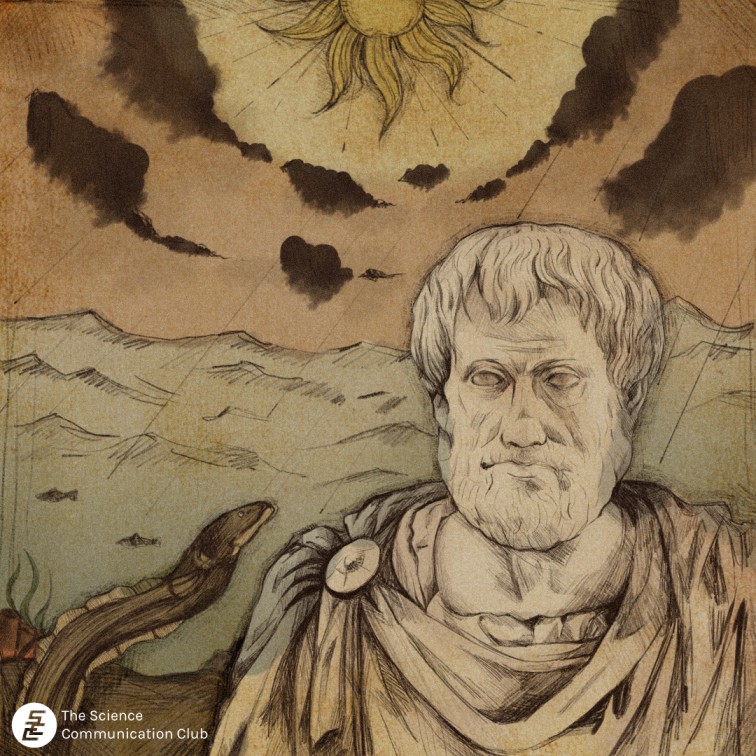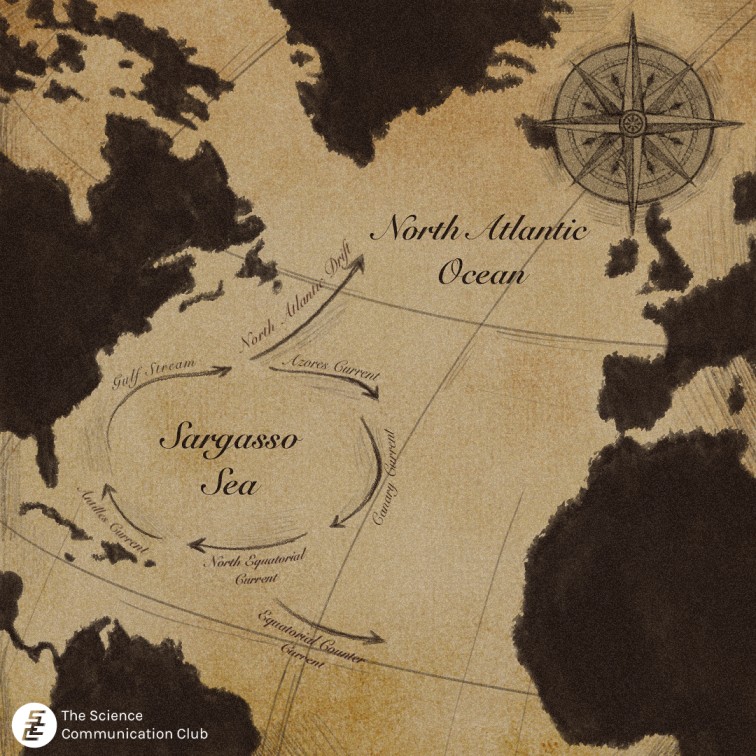
Written by Jem Barrett
Illustrated by Carrie He
In the fourth century BCE, Aristotle wrote that while most fish lay eggs and breed, eels do not. They are neither male nor female, they do not lay eggs, nor do they mate.1 According to his theory, eels occurred spontaneously out of the mud, brought to life by plain ol’rainwater.2 While this theory may seem unrealistic to us today, the mystery of eel reproduction was prevalent in the scientific community for many centuries. Natural philosopher Pliny the Elder, who died in the eruption of Mount Vesuvius in 79 AD, believed that eel reproduction occurred when they rubbed up against rocks, releasing skin particles that then became eels.3 Others believed that eels appeared out of sea foam, while in the English countryside, eels were thought to be born when hairs from horses’ tails fell into the water.3 These wild theories were made plausible by the fact that American and European eels do not possess reproductive organs until they reach sexual maturity, by which point they are already traveling back to the Sargasso Sea.3 For many, many years, eels were thought to have no reproductive organs.
In the 18th century, a professor named Pietro Molinelli even offered a reward for anyone that could find an eel with eggs inside. But the only specimen he received turned out to have been stuffed full of eggs from an entirely different species altogether.3 Only in 1777 did the scientific community obtain an eel specimen that was dissected by Carlo Mondini to reveal reproductive organs and tiny eggs within, proving definitively that eels did not simply materialize out of thin air.3 Even Sigmund Freud, who is often referred to as the father of psychoanalysis, was intrigued by this scientific mystery.3
At this point more than 2,000 years had passed since Aristotle first theorized that eels appeared spontaneously in the mud, and yet no one had ever found the testicles of an eel. Furthermore, no one other than Mondini had found an eel with reproductive organs, male or female. But, at 19 years of age, in 1876, Freud was sent from his studies at the University of Vienna to a research station in Trieste where a mature male eel was rumoured to have been discovered.3 Four hundred eel dissections later, Freud had to admit failure as he could not definitely prove that a single one of these eels was male. Just 20 years after Freud tried his luck, a sexually mature male eel was discovered just off the coast of Messina in Sicily.3

The next mystery to unravel was where the spawning of these eels actually occurred. After two decades of traveling the Atlantic Ocean and carefully examining thousands and thousands of eel larvae, in 1921, Johannes Schmidt found the very smallest specimens in close proximity to the Sargasso Sea, the only sea in the world without land boundaries.3 Instead, its borders are defined by four powerful ocean currents; the Gulf Stream, the North Atlantic Drift, the Canary Current, and the North Equatorial Current.4
Two million square miles in size, the Sargasso Sea is even more remarkable due to the presence of immense swaths of the brown algae Sargassum, from which the Sea gets its name.5 Once thought to be a barren oceanic desert5, we now know that the Sargasso Sea is teeming with life.4 While other drift algae habitats do exist, they occur in coastal waters and are often short-lived. The Sargasso Sea, on the other hand, has persisted for many, many years and is remarkable for its size, its presence in the middle of the open ocean, and its unique surface ecosystem characterized by mass amounts of Sargassum.4 The Sargasso Sea is essentially an oceanic crossroads that functions as a nursery and feeding area for many species while acting as a stop on the migratory route of many others. There are ten species that are, in fact, endemic to the Sargasso Sea, including the Sargasso crab, shrimp, pipefish, anemone, and more.4 Juvenile swordfish, jacks, dolphinfish, filefish and triggerfish can all be found amongst the Sargassum canopy. Whale sharks, tiger sharks, manta rays and spotted eagle rays all can be found in the region as well, either as permanent residents or passersby on a longer migratory route.4 Incredibly, 30 different species of whales and dolphins have been spotted within the Sargasso Sea.4
Several species that undergo a portion of their life shrouded in mystery do so in the Sargasso Sea, hidden by the mats of Sargassum. Many turtle species that hatch along the Caribbean shoreline spend their “lost years” hidden amongst its weeds, including the endangered green turtle, hawksbill turtle, loggerhead turtle, and Kemp’s Ridley turtle.4 The vast seaweed landscape also provides spawning grounds for the white marlin, the blue marlin, and, of course, the European and American eel.4 From its endemic species to the many global species that rely on this unique habitat, the importance of the Sargasso Sea is undeniable.
After centuries of research, we now know American and European eels are born in the Sargasso Sea. As a catadromous fish, despite being born in saltwater, eels then migrate to freshwater, where they spend the majority of their life.6 Once they reach sexual maturity, they metamorphize into silver eels and begin their journey back to their birth spot, where they will reproduce once and then die.6 The Ocean Tracking Network followed 8 silver eels from Nova Scotia to the Atlantic Ocean in 2015 and even managed to successfully track one to the Sargasso Sea.7 This was the first time that this incredible voyage had been confirmed. To date, no one has witnessed the birth of an eel or their mating process, and no one has ever managed to successfully breed them in captivity.
- Aristotle. 350 BCE. Book IV in Historia animalium (The History of Animals). Translated by D’Arcy Wentworth Thompson. Oxford: Clarendon Press, 1910. Accessed from: https://classics.mit.edu/Aristotle/history_anim.html
- 350 BCE. Book VI in Historia animalium (The History of Animals). Translated by D’Arcy Wentworth Thompson. Oxford: Clarendon Press, 1910. Accessed from: https://classics.mit.edu/Aristotle/history_anim.html
- Svensson P. 2020. The Book of Eels: Our Enduring Fascination with the Most Mysterious Creature in the Natural World. Broomé A, translator. New York: HarperCollins Publishers. 241 p. Translation of the 2019 edition.
- Laffoley Dd’A , Roe HSJ, Angel MV , Ardron J, Bates NR, Boyd IL, Brooke S, Buck KN , Carlson CA, Causey B, Conte MH, Christiansen S, Cleary J, Donnelly J, Earle SA, Edwards R, Gjerde KM, Giovannoni SJ, Gulick S, Gollock M, Hallett J, Halpin P, Hanel R, Hemphill A, Johnson RJ, Knap AH, Lomas MW, McKenna SA, Miller MJ, Miller PI, Ming FW, Moffitt R, Nelson NB, Parson, L, Peters AJ, Pitt J, Rouja P, Roberts J, Roberts J, Seigel DA, Siuda ANS, Steinberg DK, Stevenson A, Sumaila VR, Swartz W, Thorrold S, Trott TM, and Vats V. 2011. The protection and management of the Sargasso Sea: The golden floating rainforest of the Atlantic Ocean. Summary Science and Supporting Evidence Case. Sargasso Sea Alliance, 44 pp. http://www.sargassoseacommission.org/storage/documents/Sargasso.Report.9.12.pdf
- Ryther JH. 1956. The Sargasso Sea. Scientific American 194(1): 98-108.
- Tesch F. 2003. Chapter 3 in “The eel.” Oxford, UK: Blackwell Science Ltd. Accessed from: https://onlinelibrary-wiley-com.myaccess.library.utoronto.ca/doi/epdf/10.1002/9780470995389.ch3
- Béguer-Pon M, Castonguay M, Shan S, Benchetrit J, Dodson JJ. 2015. Direct observations of American eels migrating across the continental shelf to the Sargasso Sea. Nature Communications 6(8705)